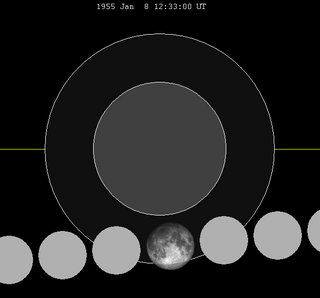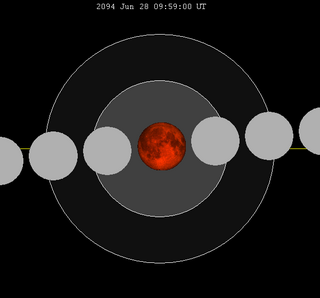
A penumbral lunar eclipse took place on Saturday, January 8, 1955. [1]

A penumbral lunar eclipse took place on Saturday, January 8, 1955. [1]
| Descending node | Ascending node | |||||
|---|---|---|---|---|---|---|
| Saros | Date Viewing | Type Chart | Saros | Date Viewing | Type Chart | |
| 103 | 1951 Feb 21  | Penumbral | 108 | 1951 Aug 17  | Penumbral | |
| 113 | 1952 Feb 11  | Partial | 118 | 1952 Aug 5  | Partial | |
| 123 | 1953 Jan 29  | Total | 128 | 1953 Jul 26  | Total | |
| 133 | 1954 Jan 19  | Total | 138 | 1954 Jul 16  | Partial | |
| 143 | 1955 Jan 8  | Penumbral | ||||
| Last set | 1951 Mar 23 | Last set | 1951 Sep 15 | |||
| Next set | 1955 Nov 29 | Next set | 1955 Jun 5 | |||
A lunar eclipse will be preceded and followed by solar eclipses by 9 years and 5.5 days (a half saros). [2] This lunar eclipse is related to two partial solar eclipses of Solar Saros 150.
| January 3, 1946 | January 14, 1964 |
|---|---|
 |  |
The saros is a period of exactly 223 synodic months, approximately 6585.3211 days, or 18 years, 10, 11, or 12 days, and 8 hours, that can be used to predict eclipses of the Sun and Moon. One saros period after an eclipse, the Sun, Earth, and Moon return to approximately the same relative geometry, a near straight line, and a nearly identical eclipse will occur, in what is referred to as an eclipse cycle. A sar is one half of a saros.

A penumbral lunar eclipse took place on Sunday, December 30, 2001, the last of three lunar eclipses in 2001.

A total lunar eclipse took place on Friday 21 January 2000, the first of two total lunar eclipses in 2000.

A total lunar eclipse took place at 0308 UT (GMT) on Thursday, August 17, 1989, the second of two total lunar eclipses in 1989.

A total lunar eclipse took place on Monday, November 29, 1993, the second of two total lunar eclipses in 1993, the first was on Friday, June 4.

A penumbral lunar eclipse took place on Sunday, September 6, 1998, the last of three lunar eclipses in 1998.

A total lunar eclipse will take place on August 7, 2036. The southern tip of the moon will pass through the center of the Earth's shadow. This is the last central lunar eclipse of Saros cycle 129.
A total lunar eclipse took place on Monday, October 28, 1985, the second of two total lunar eclipses in 1985, the first being on May 4, 1985.

A penumbral lunar eclipse took place on Friday, July 26, 1991, the third of four lunar eclipses in 1991. This was the 2nd member of Lunar Saros 148. The previous event was on 15 July 1973, and the 1st eclipse of the series. The next event was on 6 August 2009.

A penumbral lunar eclipse took place on Wednesday, January 30, 1991, the first of four lunar eclipses in 1991.
A partial lunar eclipse will take place on Saturday, 28 October 2023.
A penumbral lunar eclipse will take place on Monday, March 25, 2024. It will be visible to the naked eye as 95.57% of the Moon will be immersed in Earth's penumbral shadow.

A total lunar eclipse took place on Monday, May 13, 1957, the third of fourteen total lunar eclipses of Lunar Saros 130. The Moon was plunged into darkness for 1 hour and 18 minutes, in a deep total eclipse which saw the Moon 30% of its diameter inside the Earth's umbral shadow. The visual effect of this depends on the state of the Earth's atmosphere, but the Moon may have been stained a deep red colour. The partial eclipse lasted for 3 hours and 32 minutes in total.
A partial lunar eclipse took place on Sunday, April 12, 1903. This nearly total lunar eclipse of Saros cycle 130 preceded the first total eclipse on April 22, 1921. The Moon was almost covered by the Earth's shadow in a very deep partial eclipse, which lasted 3 hours and 17 minutes. With 96.77% of the Moon in shadow at maximum eclipse, this was quite a memorable event.

A total lunar eclipse will take place on July 29, 2083. The Moon will be plunged into darkness for 1 hour and 30 minutes, in a deep total eclipse which will see the Moon 48.3% of its diameter inside the Earth's umbral shadow. The visual effect of this depends on the state of the Earth's atmosphere, but the Moon may be stained a deep red colour. The partial eclipse will last for 3 hours and 33 minutes in total.

A total lunar eclipse will take place on June 28, 2094. The moon will pass through the center of the Earth's shadow. While the visual effect of a total eclipse is variable, the Moon may be stained a deep orange or red color at maximum eclipse. With a gamma value of only 0.0288 and an umbral eclipse magnitude of 1.8234, this is the greatest eclipse in Saros series 131 as well as the second largest and darkest lunar eclipse of the 21st century.
A partial lunar eclipse took place on Thursday, March 12, 1914.

A partial lunar eclipse took place on Tuesday, November 29, 1955 with an umbral eclipse magnitude of 0.11899. A partial lunar eclipse happens when the Earth moves between the Sun and the Full Moon, but they are not precisely aligned. Only part of the Moon's visible surface moves into the dark part of the Earth's shadow. A partial lunar eclipse occurs when the Earth moves between the Sun and Moon but the three celestial bodies do not form a straight line in space. When that happens, a small part of the Moon's surface is covered by the darkest, central part of the Earth's shadow, called the umbra. The rest of the Moon is covered by the outer part of the Earth's shadow called the penumbra. It was the second of two lunar eclipses in 1955, first being the penumbral lunar eclipse on June 5.

A penumbral lunar eclipse took place at the Moon's ascending of the orbit on Sunday, June 5, 1955, with a penumbral eclipse magnitude of 0.62181 (62.181%). A penumbral lunar eclipse takes place when the Moon moves through the faint, outer part of Earth's shadow, the penumbra. This type of eclipse is not as dramatic as other types of lunar eclipses and is often mistaken for a regular Full Moon. The Moon shines because its surface reflects the Sun's rays. A lunar eclipse happens when the Earth comes between the Sun and the Moon and blocks some or all of the Sun's light from reaching the Moon. A penumbral lunar eclipse occurs when the Sun, Earth, and the Moon are imperfectly aligned. When this happens, the Earth blocks some of the Sun's light from directly reaching the Moon's surface and covers all or part of the Moon with the outer part of its shadow, also known as the penumbra. Since the penumbra is much fainter than the dark core of the Earth's shadow, the umbra, a penumbral eclipse of the Moon is often difficult to tell apart from a normal Full Moon. Occurring only 0.5 days after apogee, the moon's apparent diameter was 6.5% smaller than average.

A total lunar eclipse will take place on September 19, 2043.